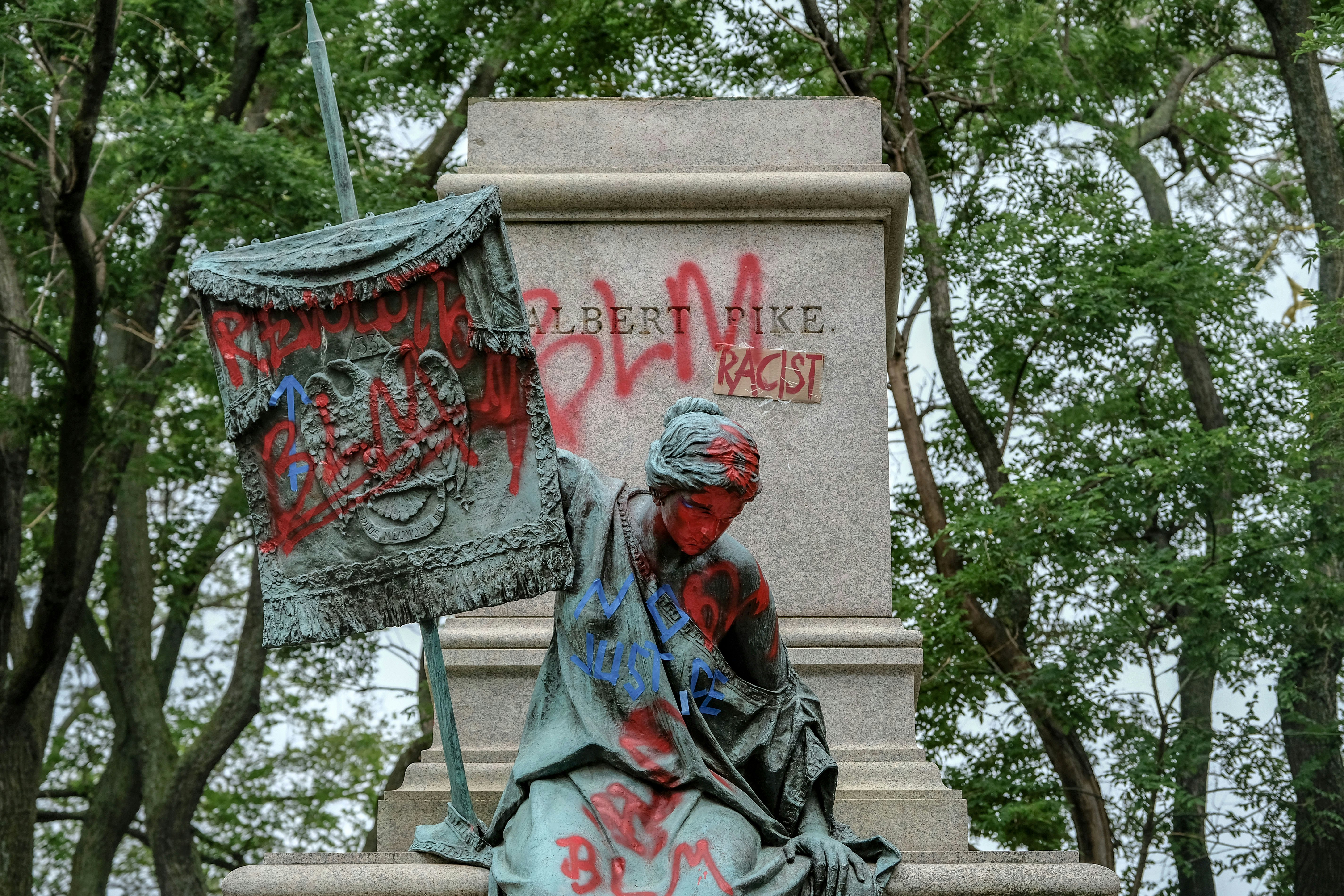
In recent years, the United States has seen increased pressure to remove Confederate monuments from public grounds. The demands to do so are driven by a number of factors, including the rising visibility of white supremacists (as seen with the 2017 Unite the Right rally in Charlottesville, Virginia, or the insurrection at the Capitol in January) and nationwide uprisings against policing, driven by the murders of Black people like George Floyd.
Previously, Mic has imagined what it would look like if all the Confederate monuments in the U.S. were replaced with ones celebrating Black heroes. It is great to picture these statues — literal symbols of white supremacy — being replaced by something better. But could that ever become a reality in the U.S.? According to a 2020 study by the Southern Poverty Law Center, Confederate monuments aren't falling all that fast. Although the study found that 270 Confederate symbols have been removed over the past few years, over 1,600 remain. Some states, like West Virginia, haven't even removed any.
Still, Confederate statues are falling. Sometimes because the city itself decides to do something, but often because protesters outright destroy them or vandalize them enough that the city has no choice but to put the statues elsewhere. Let's take a look at some Confederate monuments that have come down in the past few years.
Alabama
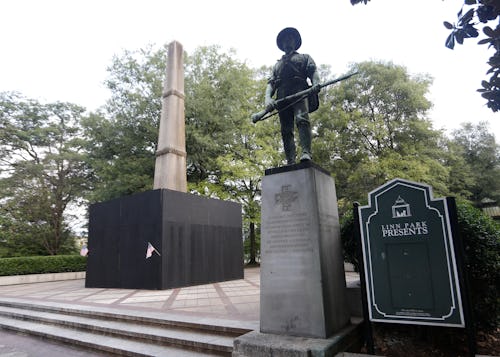
After calls to remove Confederate monuments increased in 2017, Alabama responded by passing the Alabama Memorial Preservation Act to protect them. Any cities that attempted to remove Confederate monuments would be fined. Two years later, Jefferson County Circuit Judge Michael Graffeo "reluctantly" overturned the law, but it remained in effect following an appeal.
When protesters in Birmingham tried tearing down a statue of Confederate soldier Charles Linn following the police murder of George Floyd, though, the city's mayor, Democrat Randall Woodfin, vowed to remove it — a potential $25,000 fine be damned.
This year, Democrats tried repealing the Alabama Memorial Preservation Act, but failed to do so. Meanwhile, Republicans are hoping to strengthen the law. But Confederate monuments statewide are still coming down.
Birmingham
Statue of Charles Linn
Confederate Soldiers and Sailors Monument
Montgomery
Statue of Robert E. Lee at Robert E. Lee High School
Mobile
Statue of Raphael Semmes
Tuscaloosa
University of Alabama Confederate Monument
Huntsville
Confederate Soldier Monument
Hayneville
Lowndes County Confederate Monument
Anniston
John Pelham Monument
Arizona
Phoenix
Last year, Arizona removed two Confederate monuments from its capital city of Phoenix, at the request of the United Daughters of the Confederacy. The monuments still exist, though — they've just been relocated to private property.
In a letter to the state's Department of Transportation, the United Daughters of the Confederacy (UDC) wrote, "These monuments were gifted to the state and are in need of repair, but due to the current political climate in the state, we believe it is unwise to repair them where they are located."
Arkansas
The more you look into Confederate monument removals, the more you'll notice a key theme: The removal of a monument from public grounds doesn't mean it's gone forever. A few examples below.
Bentonville
Last year, Bentonville removed a Confederate monument from its downtown square, but relocated it to a private park near the cemetery. This relocation took place due to an agreement between the Arkansas division of the UDC and the Benton County Historical Society.
Little Rock
The "Memorial to Company A, Capitol Guards" was removed in the summer of 2020, from its post near the Museum of Arkansas Military History. Two Arkansas branches of Confederate heritage groups suggested they would sue the city this spring if this monument and two others were not reinstated, per the Arkansas Democrat Gazette, but Little Rock City Attorney Tom Carpenter pushed back against the effort.
Pine Bluff
In Pine Bluff, the local UDC chapter reached an agreement to have a Confederate monument moved from the Jefferson County Courthouse to the Camp White Sulphur Springs Confederate Cemetery.
California
San Diego
Last summer, San Diego removed a Confederate monument from the city-owned Mount Hope Cemetery. There, both Union and Confederate soldiers who later lived in San Diego are buried. The monument itself names General Stonewall Jackson, a Confederate general.
In a move similar to Phoenix's, San Diego only removed the monument after the UDC requested it do so. Although the monument itself is gone, a flagpole and marker with Jackson's name were left behind.
Florida
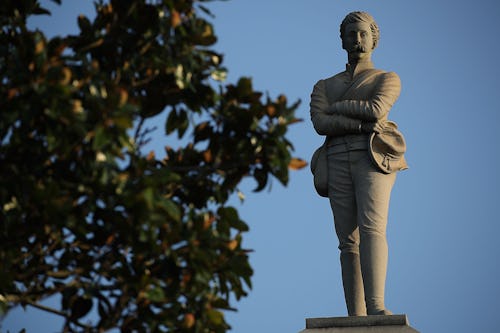
Last year, Jacksonville Mayor Lenny Curry (R) promised to remove Confederate statues from his city. And the city did remove a bronze statue of a Confederate soldier from downtown in the middle of the night.
Since then, however, not much has been done about the rest of that memorial — or several other monuments. Organizers are pressuring the mayor to keep his promise with rallies like "Take 'Em Down Jacksonville!". Similar struggles are taking place in other parts of Florida. But there have been some wins — take a look at the list below.
Fort Myers
Bust of Robert E. Lee
Madison
Madison County Confederate Monument
Palatka
Putnam County Confederate Memorial
Pensacola
Lee Square Confederate Monument
Plant City
Confederate Cow and Calvary Monument
Quincy
Gadsden Confederate Memorial
Sarasota
Judah P. Benjamin Monument
St. Augustine
Confederate Memorial Obelisk
Monument to William Wing Loring
Georgia
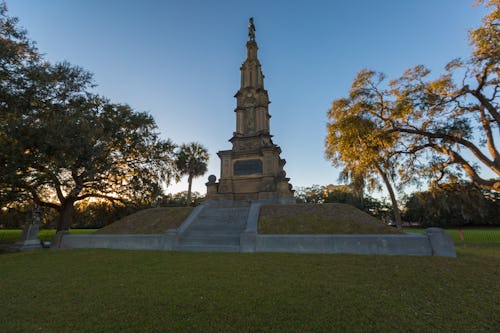
Georgia is yet another state where a law makes it nearly impossible to remove Confederate monuments. Because of it, cities like Savannah are thinking of how to revamp monuments like the one standing inside Forsyth Park. For example, removing the busts of Confederate war generals Francis Bartow and Lafayette McLaw is seen as a way to "revamp" the monument.
In other areas of Georgia, Confederate monuments are coming down. But not always for good — the city of Athens, for example, removed its Confederate monument, but it's actually just being stored until it can be installed someplace else. Here are some other Confederate monuments that have been removed across the Peach State.
Decatur
DeKalb County Confederate Monument
Conyers
Rockdale County Confederate Monument
McDonough
Henry County Confederate Monument
Macon
Confederate Soldier Monument
Indiana
Last June, the city of Indianapolis removed a monument dedicated to Confederate soldiers who died at a Union prison camp from Garfield Park.
Originally built in 1923, the monument first sat in Greenlawn Cemetery. Then in 1928, public officials who were active in the Ku Klux Klan had it moved to Garfield Park so it would be more visible. In a statement about the monument's removal, Indianapolis Mayor Joe Hogsett (D) said, "Our streets are filled with voices of anger and anguish, testament to centuries of racism directed at Black Americans."
He continued, "Whatever original purpose this grave marker might once have had, for far too long it has served as nothing more than a painful reminder of our state's horrific embrace of the Ku Klux Klan a century ago."
Kentucky
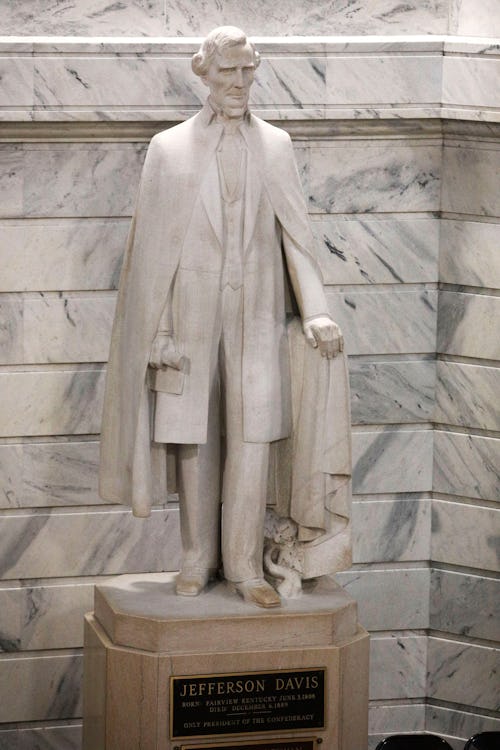
Last year, Kentucky finally removed a statue of Confederate President Jefferson Davis from its state capitol building. In a tweet, Gov. Andy Beshear (D) wrote, "After calling for its removal and urging the Historic Properties Advisory Committee to Act, today I pressed the button to bring it down."
"Now, every child who walks into their Capitol feels welcome," he continued. "Today we took a step forward for the betterment of every single Kentuckian."
The statue hasn't been destroyed, though. Per The Guardian, the Historic Properties Advisory Committee voted to move it to the Jefferson Davis State Historic Site where Davis was born.
Louisville also removed a Confederate monument in June 2020, this one a statue of Confederate officer John B. Castleman. Its removal came after a long battle that even included a 2019 lawsuit by a local art group that wanted the statue to remain where it was. Like Davis's statue, Castleman's has not been destroyed. It's supposed to be moved to the Cave Hill Cemetery where Castleman is buried.
And once again following that relocation-not-ruin theme, a Confederate monument in Owensboro will be removed from the Daviess County Courthouse lawn. But it is going to be relocated once the monument's owner is determined.
Louisiana
In New Orleans, a bust of Charles Didier Dreux, the first Confederate field officer killed during the Civil War, was a popular target for protesters. A few years ago, someone spray-painted "bigot" around the pedestal and, later that same year, it was covered in a white hood and tagged with "F*ck This Sh*t".
Each time, the city fixed the statue. But after the bust was toppled in June 2020, New Orleans didn't announce any plans to restore it. So, sure, that's not a removal by the city, but it counts, right? Here are some other Confederate monuments that have come down in Louisiana.
Lafayette
Statue of Alfred Mouton
Lake Charles
The South's Defenders
Minden
Confederate Monument
Plaquemine
Iberville Parish Confederate Monument
Port Allen
Statues of Henry Watkins Allen
Shreveport
Caddo Parish Confederate Monument
Maryland
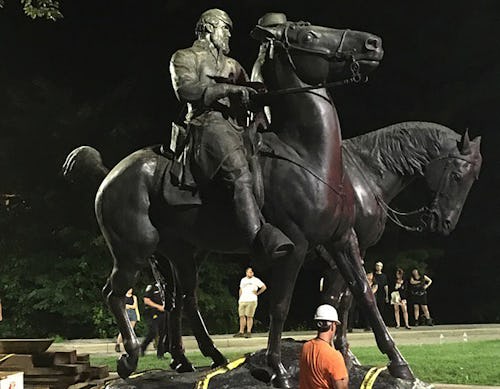
Over the past couple of years, Baltimore has removed quite a few Confederate monuments. In 2017, it removed four statues — including one of Confederate generals Robert E. Lee and Stonewall Jackson on horseback — in just a five-hour period. The aforementioned statue of Lee and Jackson was moved to a secret city lot for protection.
Baltimore isn't the only city getting rid of these monuments, though. A few others have removed or relocated monuments, too.
Dickerson
Montgomery County Confederate Soldiers Monument
Frederick
Statue of Confederate soldier
Lothian
Statue of Benjamin Welch Owens
Silver Spring
Confederate soldier grave marker
Mississippi
According to data from the Southern Poverty Law Center, Mississippi has the third highest number of remaining Confederate symbols, at a whooping 147. If that wasn't bad enough, the state is also especially slow at removing Confederate monuments.
Despite mounting calls to remove Confederate monuments in the past few years, the SPLC reported that 99% of Mississippi's remain intact. Still, that means 1% have come down! Here are a few of them.
Cleveland
Bolivar County Confederate Monument
Columbus
Lowndes County Confederate Soldier
Greensville
Washington County Confederate Monument
Oxford
Confederate Monument
Missouri
In June 2020, the Cape Giradeau Historic Preservation Commission recommend the removal of a Confederate monument at Ivers Square. Two months later, the monument was taken down — but not destroyed.
The city had the monument in storage until it could locate a better place for it. But in September, the local UDC reclaimed the monument, stating, "The monument was purchased, fabricated, and erected in 1931 by the United Daughters of the Confederacy with the agreement and understanding of the city of Cape Girardeau, Missouri, that the memorial was to be displayed in the city and perpetually cared for and protected by the city."
"Therefore, we will cooperate with the city to remove the memorial back into our custody and care, thus eliminating the city's current burden regarding it."
Nevada

Since 1982, the mascot of the University of Nevada at Las Vegas was Hey Reb! According to the Reno Gazette Journal, the mascot was modeled after Western settlers of the 1800s. It often faced criticism for that, as well as the fact that its original look was of a wolf wearing Confederate Army garb.
Last year, UNLV actually removed a statue of Hey Reb! following calls from the university's Native American Association and protests sparked by Floyd's death. The NAACP had also been calling for its removal. Las Vegas Chapter President Roxann McCoy told KSNV, "You can try to like dance around it and say, 'It's not Confederate.' When you put 'rebel,' then you put that image there, um, I'm not looking at just some old white man with a big hat hanging out in Vegas."
This year, UNLV retired Hey Reb! altogether — but the university plans on keeping the "rebel" name.
North Carolina
North Carolina is another state with a ton of Confederate symbols. Per the SPLC, it has over 160, and while North Carolina has removed the most symbols since 2013, at least 95% of them still remain.
But, hey, we may as well celebrate some progress! Let's take a look at a list of some of the Confederate monuments that North Carolina has removed.
Asheville
Zebulon Baird Vance Monument
Monument to 60th Regiment NC Volunteers and Battle of Chickamauga
Clinton
Sampson County Confederate Monument
Cornelius
Mt. Zion Confederate Monument
Elizabeth City
Pasquotank County Confederate Monument
Fayetteville
Confederate Monument
Monument to Confederate Dead
Confederate Monument (Cross Creek Cemetery)
Gastonia
Gaston County Confederate Memorial
Greensboro
Greensboro Confederate Statue
Greenville
Pitt County Confederate Soldiers Monument
Kinston
Lenoir County Confederate Monument
Lexington
Uptown Square Confederate Monument
Louisburg
"To our Confederate dead" Monument
Oxford
The Granville Gray
Raleigh
North Carolina State Confederate Monument
Statue of Lawson Wyatt
Monument to North Carolina Women of the Confederacy
Rocky Mount
Nash County Confederate Monument
Salisbury
Gloria Victis
Wadesboro
Anson County Courthouse Confederate Monument
Warrenton
Warrenton County Confederate Soldiers Monument
Wilmington
Confederate Monument
George Davis Monument
Oklahoma
Last June, the Cherokee Nation removed two confederate monuments from its Capitol Square in Tahlequah that had stood for nearly a century. Dedicated by the daughters of the Confederacy, the monuments recognized Stand Watie, a Cherokee general who signed away his ancestral lands and fought for the Confederacy.
"It's difficult to tell our story when we have non-Indian-driven monuments talking about the Confederacy, when they greet people as they come into our Cherokee Nation museum," Principal Chief Chuck Hoskin, Jr. said in a statement. "It was time for a change."
South Carolina
According to the SPLC, South Carolina has the largest remaining percentage of Confederate symbols, at a whopping 98%. Let's take a look at two statues that did get cut.
Charleston
Last year, Charleston removed a statue of former Confederate Vice President John C. Calhoun, who was pro-slavery, from Marion Square. The statue's removal, of course, came following protests around Floyd's murder in Minneapolis. There, residents have similarly protested Calhoun's representation in the city, renaming a lake dedicated to him to Bde Maka Ska, which was the original Dakota name for the lake.
Orangeburg
Last year, Orangeburg's city council voted unanimously to remove a Confederate monument from a courthouse lawn. The monument's removal, however, was pending approval from the South Carolina State Legislature due to the Heritage Act. A group called the Orangeburg Revitalization Coalition sued in hopes that a judge would find the act unconstitutional and allow the city to remove the monument.
Passed in 2000, the Heritage Act doesn't allow for the removal of any historical monuments on public property. It was passed after a Confederate flag on the statehouse was moved to a nearby monument. That flag was later removed entirely after a white supremacist massacred nine Black people at the Charleston Mother Emanuel AME Church.
Tennessee
Did you know there's a "Boy Hero of the Confederacy"? I didn't until I wrote this article, and I wish I could go back to being ignorant.
Sam Davis was a Confederate soldier executed by the Union in Pulaski, Tennessee. Even though he was 21 at the time, he's become a boy hero of sorts. So he's the perfect Confederate figure to put on school grounds, right?
Last year, the Montgomery Bell Academy in Nashville announced its plans to remove a statue of Davis from school grounds. And in another win for Nashville, the city got permission to remove a bust of Nathan Bedford Forrest, a Confederate Army general who went on to become the first grand wizard of the KKK, this year. Hopefully, it doesn't go the way of a Confederate monument in Clarksville, that was removed, stored for a few months, and then put right back onto Cumberland Drive.
Texas
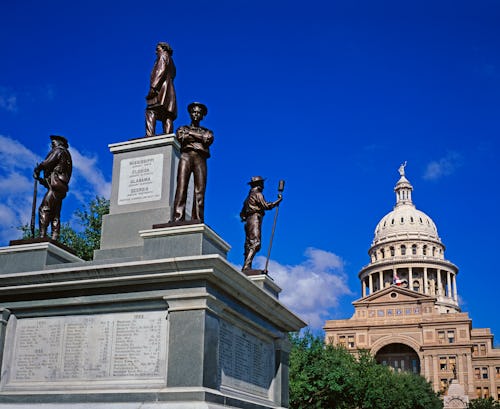
Last year, Houston removed the Spirit of the Confederacy Statue from downtown's Sam Houston Park, as well as a statue of Confederate lieutenant Dick Howling in Herman Park. Predictably, however, the city took them down with plans to relocate them.
Still, it's progress, I guess? Here's some other statues that have been removed in Texas.
Beaumont
Our Confederate Soldiers
Dallas
Confederate War Memorial
Denton
Denton Confederate Soldier Monument
Fort Worth
Confederate Monument
Gainesville
Leonard Park Confederate Monument
Houston
Spirit of the Confederacy
Statue of Richard W. Dowling
Lockhart
Caldwell County Confederate Memorial
Virginia
Four years ago, white supremacists descended upon Charlottesville, Virginia, in droves for the infamous Unite the Right rally. There, they gathered around a memorial dedicated to Confederate General Robert E. Lee.
Rather than taking that rally as a sign to get rid of Confederate monuments, Virginia has been incredibly hesitant to do so. Per the SPLC, the state had the most remaining Confederate symbols overall at 228.
Of course, that's not for a lack of trying by some in the state. For example, city officials in Charlottesville have wanted that memorial of Lee gone, but have faced legal challenges. This weekend, however, Charlottesville finally got a win: The city removed not only the statue of Lee, but also a second one commemorating Stonewall Jackson. They'll be held in storage.
Washington
Last year, protesters toppled a monument to Confederate veterans that stood in a Seattle cemetery. The monument had stood for nearly a century and had been the target of earlier conversations on removing Confederate monuments.
The cemetery had cleaned up all of the monument's rubble by September, and there are no plans to restore it. A representative told the Capitol Hill Seattle blog, "There's no process to restore it. It's gone. The vandals came in and they just ruined it but we were in the process of getting rid of it anyway."
Washington, D.C.

Since 2017, organizers in Washington, D.C., have pushed for the removal of a memorial to Albert Pike, a senior officer of the Confederacy. Because the statue is on federal land, D.C. officials could not do so without Congress's approval.
Protesters eventually took care of that. Last year, on Juneteenth, a group of protesters tore down the statue and set it on fire. Although the D.C. monument was more about his contributions to the Freemasons than to the Confederacy, an organizer of a 2017 rally against it told DCist, "It doesn't matter that he's not being honored as a Confederate general. He still has a long history of supporting racist causes."







